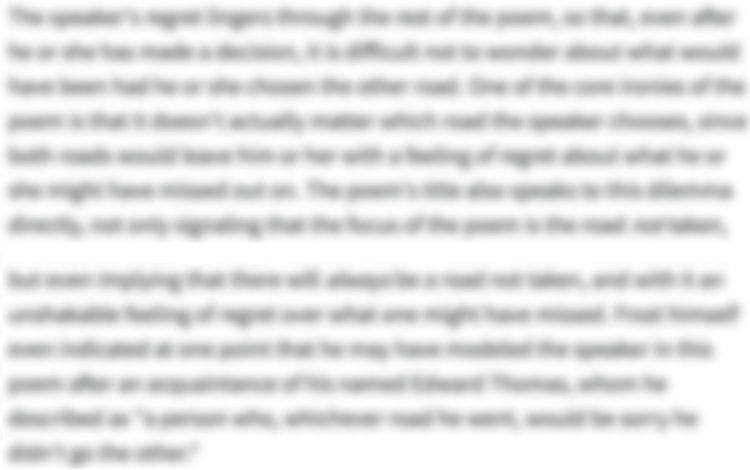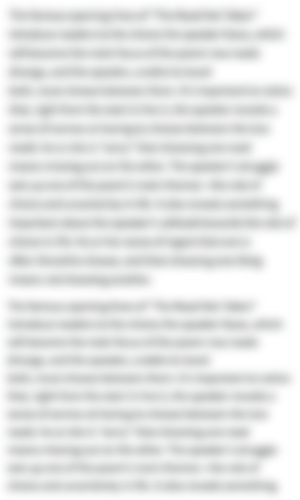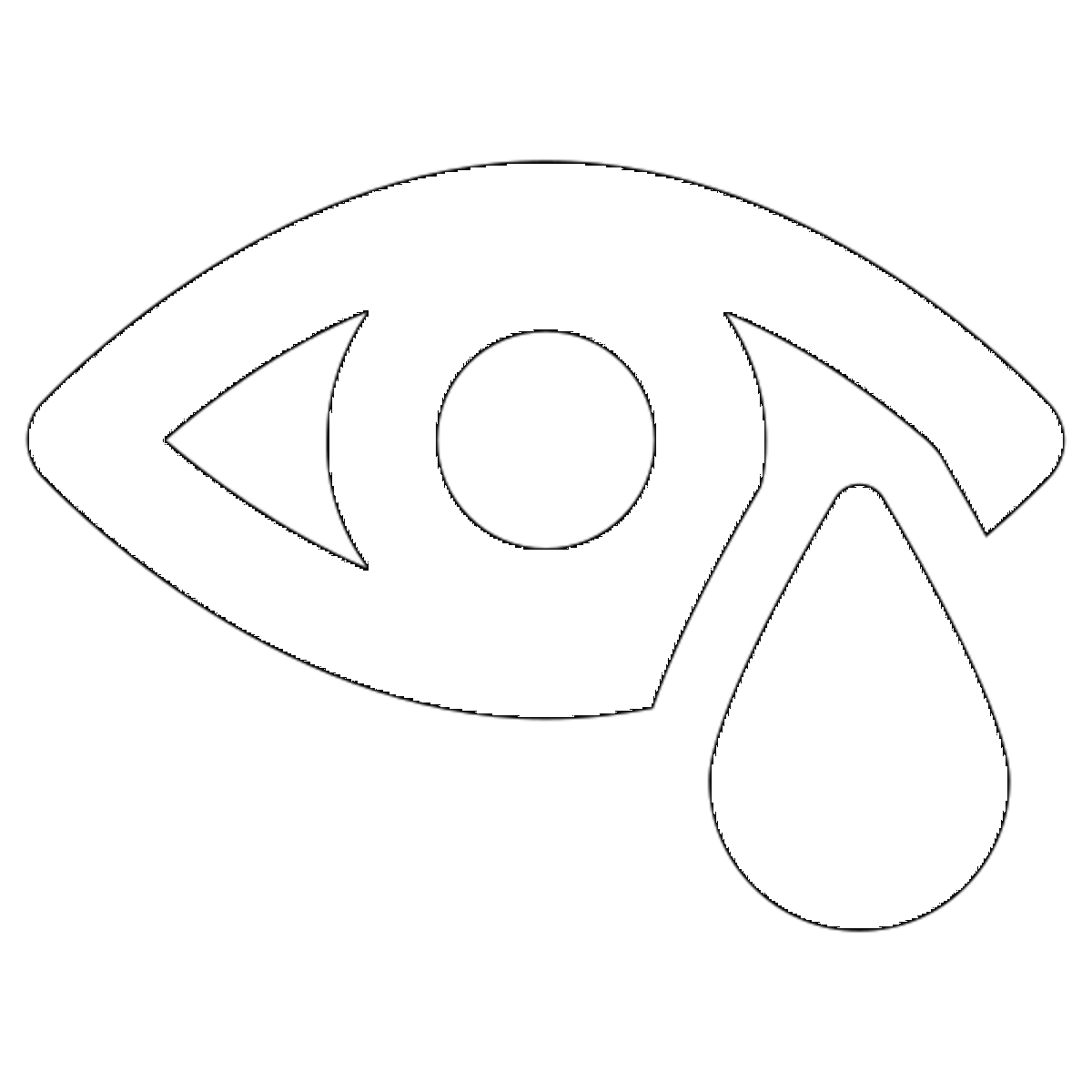-
“The Man-Moth” Introduction
-
"The Man-Moth" tells the story of an elusive, city-dwelling creature who lives underground and only emerges at night. The Man-Moth climbs buildings in an attempt to reach the moon, which he thinks is a hole in the sky, but fails every time. Later, he returns home via "silent" subway trains on which he doesn't speak to anyone. The poem's surreal imagery allows for many interpretations, but its themes broadly revolve around perseverance, ambition, hope, and disappointment. The enigmatic Man-Moth seems detached from everyone around him, and his lonely surroundings further evoke the hollowness of urban life. In his relentless compulsion to reach the moon, the Man-Moth might also symbolize the artist's compulsion to create. "The Man-Moth" appeared in Bishop's 1946 collection North and South, but she wrote the poem about a decade earlier while in her 20s and living in Manhattan—a place that proved formative for her career but which she also found deeply isolating. The title was inspired by a newspaper typo for "mammoth."
-
-
“The Man-Moth” Summary
-
The phrase "Man-Moth" was a typo that appeared in a newspaper instead of the word "mammoth."
Seen from above, worn, threadbare moonlight illuminates cracks in the buildings. Man's entire shadow is barely the size of the bowler hat he's wearing; it has shrunk down to his feet, looking like a little display platform for a doll. He is like a pin standing up on one end, and it's as if the moon were a powerful magnet keeping him upright. He can't see the moon, but he notices the strange effect it has. He can feel the moon's strange light on his hands even though that light isn't hot or cold (it has no temperature a thermometer could pick up, anyway).
But whenever the Man-Moth comes to the surface (which he doesn't do often), he sees the moon differently. He crawls up from under the lip of the sidewalk and nervously begins to climb up the sides of buildings. He believes that the moon is actually a small opening, like a porthole or a manhole, and, as a result, thinks the sky can't really keep him safe. The Man-Moth is frightened, but he has to get as close as he can to check things out for himself.
He climbs, anxiously, up the side of the buildings, his long shadow following behind him like the cloth used by an old-school photographer, all along believing that this time he will be able to poke his small head through the crisp hole of the moon and then squeeze through, like ribbons of black being squeezed from a tube. (Man, who keeps both his feet on the ground below the Man-Moth, doesn't imagine any of this.) Even though the Man-Moth is afraid, he has to persevere—in fact, he has to keep going because he is afraid. Naturally, though, he falls short and tumbles back down to the ground. He's shaken, but not injured.
The Man-Moth goes back underground into the cement subway tunnels, where he lives. He darts here and there, but it still feels like he's moving too slowly as he climbs into the silent subway car. The doors shut quickly. The Man-Moth always chooses to sit backwards (ie., facing away from the direction the train is moving in), and the train hurtles forward from a standstill, without having to gradually speed up at all. Sitting backwards, the Man-Moth can't tell how fast he's going.
Every night he has to let the train carry him through the manmade subway tunnels and dream the same dreams. These dreams come to him again and again, like the train tracks repeating underneath the train. He can't look out the window: the electrified third rail is always there beside him, like a drink of poison. He thinks he's inherited a vulnerability to thoughts like these, the way that some people are vulnerable to certain diseases. He has to keep his hands in his pockets just in case, the way the other people keep their hands inside of mufflers.
If you find the Man-Moth, shine a flashlight in his eye. There's no iris; it's all black, like the night sky, his lid like the horizon, which constricts as he squints back at you and then shuts his eye. Then, a single tear slips out—it's the only thing he owns, just as a stinger is all a bee has to offer. He craftily hides it in his hand, and if you're not watching closely, he'll eat it. But if you are paying attention, he'll give it to you; it's like cold, fresh spring water.
-
-
“The Man-Moth” Themes
-

The Isolation and Loneliness of Urban Life
Bishop's poem, which tells the story of a shy creature called the "Man-Moth," comments on the hollowness and alienation of modern urban life. The Man-Moth lives a lonely life underground and creeps out from underneath the sidewalk at night, drawn by a futile desire to climb up to the moon. Life on the surface, however, seems no more vibrant or welcoming than the subterranean home to which the Man-Moth inevitably retreats alone in failure. The poem suggests that this desolation and repetitiveness are typical of modern cities, which push people to disengage from the world and from each other.
The poem describes a city that seems desolate and decrepit. Despite its modern features (tall buildings, fast underground trains, "artificial tunnels") the city itself seems "battered" and worn; the buildings are laced with "cracks." The poem's imagery suggests that this metropolis, and perhaps urban life in general, is uninspiring and depressing—a crumbling facade covering up a meaningless existence. This isn't an inspiring city of the future but rather a place that has ground down its residents; "Man," unlike the Man-Moth, harbors no "illusions" and makes no attempt to escape.
The Man-Moth's visits to the surface are "rare," and he spends his nights riding "silent trains" through the "pale subways of cement he calls his home." The train's silence and pallor again suggest that this city is cold, lifeless, and unfriendly. The Man-Moth doesn't hear the voices of the other passengers or of the train announcer; it's as if he lives in a bubble and is used to going unnoticed and unseen. Indeed, the Man-Moth intentionally "seats himself facing the wrong way," cutting himself off from his surroundings. His solitude might suggest that the pace and technologies of the modern world discourage reflection and connection.
The fact that the train also moves "swiftly" and with "full, terrible speed" supports this idea. Like the train, modern life doesn't allow for "a shift in gears or a gradation of any sort." It barrels forward regardless of one's comfort or ability to adapt. And outside the subway windows, the underground tunnels are a rushing blur and the Man-Moth cannot tell how fast he is traveling "backwards." Literally, he's backward because he's sitting in the wrong direction; symbolically, however, this implies that he's not making any progress, not moving towards any meaningful destination. His rushed yet pointless journey might evoke the hollowness of busy urban existence, in which people rush to and from jobs that don’t matter day in and day out.
Because the city offers neither purpose nor connection, the Man-Moth withdraws. Perhaps the modern world actually encourages people to retreat further from the world like the Man-Moth, to the point that they, too, begin to seem not quite human.
Where this theme appears in the poem:- Lines 1-8
- Lines 11-13
- Lines 17-22
- Lines 25-32
- Lines 33-40
-

Failure, Despair, and Self-Destruction
The Man-Moth believes that the moon is actually a hole in the sky, and he repeatedly tries—and fails—to reach it. On one level, the Man-Moth's persistent attempts to climb to the moon might be read as an inspiring testament to the power of hope. At the same time, however, these attempts might represent a futile desire for fulfillment or escape that leaves the Man-Moth trapped in a self-destructive cycle of disappointment and despair.
If the Man-Moth could just reach the moon, he thinks he'll be able to see beyond, and perhaps even leave, the grim city in which he lives. He's never even come close, but that doesn't matter. Although he has failed many times before, the Man-Moth believes that "this time, he will manage / to push his small head through that clean round opening" and break through to the other side. The speaker notes that "he fails, of course," highlighting both the futility and the relentlessness of his efforts.
Each night, after failing to reach the moon, the Man-Moth rides the subway plagued by thoughts of self-destruction, suggesting that his disappointment makes him want to disengage with life altogether. He gets on the train as fast as he can, apparently eager to leave the surface world behind. He "dares not look out the window," acutely aware of the deadly "third rail, the unbroken draught of poison," that "runs there beside him." These lines suggest that he feels drawn to the rail and the possibility of death it represents. (The mention of "poison" might also allude to Elizabeth Bishops's own self-destructive habits—namely, alcoholism—and convey the overwhelming urge to escape or numb the pain of disappointment.)
Afraid of risking self-destruction, the Man-Moth doesn't allow himself to touch or interact with his surroundings: "He has to keep / his hands in his pockets." Doing so might stop him from hurting himself, but it further limits his opportunities for connection and makes his loneliness even more complete.
Where this theme appears in the poem:- Lines 9-16
- Lines 17-24
- Lines 25-32
- Lines 33-40
-

Ambition and Perseverance
Whenever he visits the surface, the Man-Moth "must investigate" the moon. Although it frightens him to climb so high, he keeps pursuing his dream and picking himself back up after he (inevitably) fails. In this way, the poem can be taken as a commentary on ambition, perseverance, and the elusiveness of success. The Man-Moth's actions illustrate the courage, foolishness, and loneliness of dreamers—those who seek unreachable goals, and who persist in trying to achieve the impossible.
The poem presents the moon as a mysterious and distant figure whose pull is like a magnet, tugging "Man" upright like "an inverted pin." Even though Man "does not see" it, the moon has an undeniable power over him. Her "vast properties" are intangible and defy thermometers, but Man can still feel "the queer light on his hands." The moon might represent some great unreachable goal that ordinary people are only dimly aware of but can't conceptualize, let alone try to reach.
The Man-Moth, however, does see the moon, and it "looks rather different to him." He may be an outcast, but it seems that his separation from the regular world allows him to see the ordinary world in a "different" light.
Thinking that the moon is a hole in the sky, he has a fantastical idea of what will happen when he finally is able to "push his small head through that round clean opening." He "trembles" as he "nervously" scales the buildings but "must investigate as high as he can climb." For dreamers like the Man-Moth, ambition is greater than fear. In fact, fear can be a sign that they're honoring their deepest desires. As the speaker says, "what the Man-Moth fears most he must do."
Failure, however, is inevitable: "of course," the speaker says, the Man-Moth always falls back to earth. But the Man-Moth is relentlessly hopeful and begins each climb believing "that this time he will manage" to reach the sky.
The speaker isn't necessarily making a value judgment, and the poem neither celebrates nor condemns the Man-Moth's quest. His ambition seems both admirable and foolish, and he's also a lonely figure. Perhaps the poem suggests that being a dreamer or idealist isn't just endlessly self-defeating, then, but also isolating; there's no one to share in the Man-Moth's dream. "Man," for instance, "has no such illusions"—no time for toying with fantasies or impossible goals. The Man-Moth is in this by himself.
The poem thus dramatizes the poignant beauty, pain, and disappointment of trying to achieve the unachievable—of dreaming the impossible dream. Readers and critics have taken the moon to represent all kinds of things: art, love, spirituality, self-realization. But however readers decide to interpret the moon as a symbol, the poem illustrates the alienation of longing for something that's forever out of reach.
Where this theme appears in the poem:- Lines 3-8
- Lines 9-16
- Lines 17-24
-

Artistic Creation and Compulsion
Parts of "The Man-Moth" seem to represent the fraught process of artistic creation. Readers might think of the Man-Moth and his compulsion to climb toward the moon as a stand-in for the artist who attempts to achieve something great, meaningful, and lasting. Being an artist, in this reading of the poem, requires overcoming fear ("what the Man-Moth fears most he must do") and persevering in the face of certain failure (falling short of one's artistic vision, say). The Man-Moth commits to his task over and over again; although it seems he has no other choice, he still believes that this time, "he will manage."
The Man-Moth's persistent attempts to reach the moon might represent the desire to achieve an artistic goal—perhaps to write something meaningful or create something new. The Man-Moth, like many an artist, is a societal outsider with a unique point of view ("the moon looks rather different to him"). The speaker even compares him to an old-school photographer as he climbs, "his shadow dragging like a photographer's cloth behind him." The Man-Moth believes that the moon is like a porthole he can look through to see beyond what is known and accepted. He wants to push past the limits of his own imagination and glimpse the other side.
The climb is also something the Man-Moth has to do alone—a fact that could reflect the inherent vulnerability of making art. Perhaps reflecting on your thoughts and desires, or exploring the dark corners of your psyche, and confronting the likelihood of failure aren't so different from scaling a skyscraper.
The process isn't easy. If anything, it's a test of courage and resolve as well as skill. And given that the reader knows the moon is not, in fact, a hole in the sky, the whole endeavor seems downright foolish and delusional—but the Man-Moth/artist does it anyway. In saying that "Man, standing below him, has no such illusions," the poem perhaps suggests that being an artist is a delusional, frightening prospect, yet it's also something that artists can't help but pursue. The Man-Moth doesn't just decide, again and again, to climb toward the moon. It's something he "must do"; he "must investigate as high as he can climb," pushing himself to the edge of his abilities.
Maybe there's something admirable about the Man-Moth, or maybe his quest is ridiculous and even self-destructive. But the poem suggests that for an artist, their calling is inescapable. And while the Man-Moth will never reach the moon, he does produce something rare and clear: a single tear, "cool as from underground springs and pure enough to drink." Though the Man-Moth is alone, he inspires intimacy and connection when he willingly hands over that tear, "his only possession," for others to sip.
Where this theme appears in the poem:- Lines 6-8
- Lines 9-16
- Lines 17-24
- Lines 41-48
-
-
Line-by-Line Explanation & Analysis of “The Man-Moth”
-
Before Line 1
Man-Moth: Newspaper misprint for "mammoth."
This epigraph provides interesting context about the poem's title and its mysterious subject. The strange phrase "Man-Moth," this epigraph reveals, came from a typo in a newspaper for the word "mammoth."
The word "Man-Moth" is thus the result of a mistake, a simple error that radically changed the meaning of a word. Perhaps the Man-Moth himself is also a mistake, a kind of mutant. The typo foreshadows his isolation, separate as he is from the world of both men and moths.
The absurdity of the typo might also hint at the absurdity of modern life in general; a presumably serious article was undercut by this rather hilarious typo. The silliness of this misprint also threatens to cast the Man-Moth's whole endeavor in a ridiculous light: he's essentially a parody of a superhero, a creature whose power isn't fighting crime but rather reflecting the loneliness of existence. By the poem's end, however, readers will likely empathize with this enigmatic creature and his futile yet brave and heartfelt quest to do something impossible.
-
Lines 1-5
Here, above, ...
... to the moon.

Unlock all 367 words of this analysis of Lines 1-5 of “The Man-Moth,” and get the Line-by-Line Analysis for every poem we cover.
Plus so much more...
Get LitCharts A+ -
Lines 6-8
He does not ...
... record in thermometers. -
Lines 9-16
But when the ...
... he can climb. -
Lines 17-21
Up the façades, ...
... on the light. -
Lines 22-24
(Man, standing below ...
... but quite unhurt. -
Lines 25-28
Then he returns ...
... doors close swiftly. -
Lines 29-32
The Man-Moth always ...
... he travels backwards. -
Lines 33-36
Each night he ...
... his rushing brain. -
Lines 36-40
He does not ...
... must wear mufflers. -
Lines 41-44
If you catch ...
... up the eye. -
Lines 44-48
Then from the ...
... enough to drink.
-
-
“The Man-Moth” Symbols
-

Climbing to the Moon
Readers might interpret the moon as a symbol of an unreachable or inaccessible goal.
The moon is distant—so far away, in fact, that to the Man-Moth it looks like "a small hole at the top of the sky." The Man-Moth longs to reach that "hole" and peer through it. But the reader knows that even if the Man-Moth managed to climb all the way up the tallest building in the world, he wouldn't be any closer to "push[ing] his small head through that round clean opening." Even if the Man-Moth could catapult himself into space, he'd simply discover that the moon isn't a tunnel or an opening at all. The Man-Moth's dream is utterly impossible, but he remains resolute. Really, he has no choice; he "must investigate," compelled by his curiosity, fear, and ambition.
Climbing toward the moon again and again symbolizes the foolish or naïve—but relentless—drive to achieve the impossible. This might refer to any number of things: the impossible might be great artistic achievement or escape from a bleak, stultifying reality. But just as the Man-Moth compulsively pursues the moon, the poem suggests that dreamers can't help but chase their own far-off, elusive goals.
Where this symbol appears in the poem:- Line 11: “the moon looks rather different to him”
- Line 16: “He trembles, but must investigate as high as he can climb”
- Lines 19-21: “he climbs fearfully, thinking that this time he will manage / to push his small head through that round clean opening / and be forced through,”
- Line 23: “But what the Man-Moth fears most he must do”
-

The Third Rail
To the Man-Moth, the third rail symbolizes the persistent allure of self-destruction. The third rail is electrified and extremely dangerous. Since it runs continuously beside the train and is visible to anyone looking right out the window, the presence of the third rail becomes a constant reminder of death. The Man-Moth is anxious to avoid looking out the window because the third rail is a kind of invitation, a tantalizing suggestion. After failing to reach the moon and returning to his grim underground home, the poem suggests that Man-Moth is tempted to escape his sad life by any means necessary.
Where this symbol appears in the poem:- Lines 37-38: “for the third rail, the unbroken draught of poison, / runs there beside him.”
-

The Modern City
The city's emptiness and decrepitude might symbolize the hollowness of modern life. Although cities are often associated with the promise of progress, here the buildings are riddled with cracks and even the moonlight seems "battered" and worn. The speaker also calls the sides of the buildings "façades," which, in addition to being an architectural term for outside-facing surfaces, refers to false or misleading appearances. The implication is that size and scale of the buildings in this city belie their emptiness. That is, the city might seem impressive, but life within it is lonely and meaningless.
Note, too, that the city extends underground into "artificial tunnels" where "pale subways run." The words "artificial" and "pale" further suggest that contemporary urban life, and modern life in general, is fake and sterile. It is characterized by a lack of human connection and profound loneliness and isolation.
Where this symbol appears in the poem:- Line 2: “cracks in the buildings are filled with battered moonlight”
- Line 17: “the façades,”
- Line 26: “the pale subways of cement”
- Line 27: “the silent trains”
- Line 30: “the train starts at once at its full, terrible speed”
- Line 34: “artificial tunnels”
-

The Tear
Critics have debated for decades what the Man-Moth's tear signifies. As a symbol, it's very ambiguous and open to interpretation.
One might think of it as representing the Man-Moth's hope or innocence. Despite his failures, he still believes that if he just tries again, he'll reach the moon. Even when retreats back underground, discouraged, he hasn't given up on the possibility of finding some form of escape. The tear is refreshing, "cool" and "pure"; hope is rejuvenating and invigorating, even for onlookers. It's also endlessly renewable: the Man-Moth swallows it but can reproduce it at will.
The fact that the tear is regenerative may link the Man-Moth to the figure of the artist or dreamer. His tear, like a precious work of art, must be shared with the right audience, but can't be used up.
The literary critic Helen Vendler has a slightly different interpretation. She sees the tear as a symbol of the poem itself. In this sense, poetry is the writer's rare and mysterious "sole possession." It's affecting and profound—one could even say it stings (hence the simile comparing the tear to a bee's stinger). Perhaps the Man-Moth himself is a personification of the artist's imagination, and the tear is the hard-won work of art.
Where this symbol appears in the poem:- Lines 44-48: “Then from the lids / one tear, his only possession, like the bee’s sting, slips. / Slyly he palms it, and if you’re not paying attention / he’ll swallow it. However, if you watch, he’ll hand it over, / cool as from underground springs and pure enough to drink.”
-
-
“The Man-Moth” Poetic Devices & Figurative Language
-
Simile
Similes add to the poem's eerie visual imagery while also telling readers quite a bit about both "Man" and the Man-Moth. Take lines 3-4, which feature two similes:
The whole shadow of Man is only as big as his hat.
It lies at his feet like a circle for a doll to stand on,To the speaker, situated somewhere "above," the Man's "whole shadow" appears constricted, appearing below his feet in a circle no bigger than "his hat" and looking like a little platform meant "for a doll."
These similes reinforce the omniscient speaker's perspective: the speaker is looking at this man from above, and at a distance. Note, too, that the "whole shadow of Man" refers not just to this one man's literal shadow, but, metaphorically, to the influence of humanity itself—to the "shadow" that humankind casts. The similes thus further suggest to the reader that even in a man-made setting—a city—Man's control is limited. He is not quite as free as he thinks he is. He's like a toy, a prop, with little agency. Unlike the Man-Moth, who keeps trying to reach the moon, Man is passive and resigned, stuck in one place.
In stanza 3, another simile helps connect the Man-Moth to the figure of the artist or dreamer. As the Man-Moth climbs up the side of the building, his shadow stretches out behind him "like a photographer's cloth." This is another bit of striking imagery: readers can picture that Man-Moth's shadow flowing behind him like a dark cape, the kind a superhero in a comic book might wear.
And think about how different this is from Man's shadow, which just makes a little circle underneath his feet. The Man-Moth's shadow is elongated and "dragging." And while Man gets reduced to a mere "doll," the Man-Moth gets compared to a photographer, an artist who tries to capture or reveal something new about their surroundings. The Man-Moth is trying to do something that has never been done before. He has a unique vision, the simile suggests.
Another simile in the same stanza links the Man-Moth with the world of art, as the speaker describes the Man-Moth's dream of pushing "his small head through that round clean opening [the moon] / and be forced through, as from a tube, in black scrolls on the light." While an ambiguous image, this might bring to mind black paint being squeezed from a tube onto white canvas (or even the "black scrolls" of handwriting from a pen onto a blank page).
Finally, there are two similes in the last stanza that both relate to the Man-Moth's "tear." First, the speaker compares this tear, "his only possession," to "the bee's sting." The simile relays just how vital this tear is to the Man-Moth. A bee uses its stinger when it feels threatened. And, when it comes to honey bees at least, stinging something will kill the bee: the bee will literally rip its body apart when trying to pull the stinger back out. The Man-Moth, like its fellow insect, suffers when deploying this "tear," which the speaker goes on to say is "cool as from underground springs." In other words, it's as refreshing as cool spring water.
The tear might symbolize any number of things, including the Man-Moth's hope or perhaps a piece of artwork. Perhaps it even represents the poem, with the stinger simile conveying the deep vulnerability and pain that may accompany the creation of meaningful art.
Where simile appears in the poem:- Lines 3-4: “The whole shadow of Man is only as big as his hat. / It lies at his feet like a circle for a doll to stand on”
- Line 18: “his shadow dragging like a photographer’s cloth behind him”
- Line 21: “be forced through, as from a tube, in black scrolls on the light”
- Line 45: “one tear, his only possession, like the bee’s sting, slips”
- Line 48: “cool as from underground springs and pure enough to drink”
-
End-Stopped Line


Unlock all 316 words of this analysis of End-Stopped Line in “The Man-Moth,” and get the poetic device analyses for every poem we cover.
Plus so much more...
Get LitCharts A+ -
Alliteration
-
Sibilance
-
Anaphora
-
-
“The Man-Moth” Vocabulary
Select any word below to get its definition in the context of the poem. The words are listed in the order in which they appear in the poem.
- Battered
- Inverted
- Queer
- Scale
- Façades
- Photographer's cloth
- Scrolls
- Flit
- Gradation
- Recurrent
- Ties
- Third rail
- Draught
- Susceptibility
- Mufflers
- Palms
Battered-
(Location in poem: Line 2: “cracks in the buildings are filled with battered moonlight.”)
Bruised or defaced, often from repeated blows or hard use. Here, "battered" is used figuratively to describe the buildings' worn surfaces.
-
Form, Meter, & Rhyme Scheme of “The Man-Moth”
-
Form
"The Man-Moth" is an unrhymed poem made up of six octaves, or eight-line stanzas. Although "The Man-Moth" doesn't have a perfectly regular meter, the length of each line is relatively consistent: most have between 14-15 syllables. The first line of each stanza, however, is much shorter than the rest, as readers can see in lines 1-2:
Here, above,
cracks in the buildings are filled with battered moonlight.This short line mimics the position of the Man-Moth as he climbs the buildings, placing him "above" the world below. Later, when he's returned underground, these short openings might evoke the Man-Moth's isolation—that is, the way he seems totally removed from the people around him.
Thanks to the relatively long lines and stanzas, the poem seems to unfurl slowly. The reader is drawn, bit by bit, into the Man-Moth's nocturnal world. And while the poem doesn't use a specific form, the consistent stanza pattern might evoke the repetitive nature of the Man-Moth's life. Like his "recurrent" dreams, the train tracks, and his failed attempts to reach the moon, the shape and length of each stanza are predictable.
-
Meter
"The Man-Moth" uses free verse, for the most part. This means that there's no strict pattern of stressed and unstressed syllables, which keeps the poem sounding conversational and prose-like.
That said, the lines are fairly uniform in length and sometimes fall into a loose accentual meter. That is, many lines contain a similar number of stressed beats but those beats appear in any order. For example, the first line of each stanza is always shorter than the rest and usually has just two stresses, as in "Here, above," "Up the façades," and "If you catch him."
The rest of the lines generally contain five to seven stresses. For example, here's a closer look at lines 18-20, each of which contains six stressed beats:
his shadow dragging like a photographer’s cloth behind him
he climbs fearfully, thinking that this time he will manage
to push his small head through that round clean openingThis scansion isn't exact, as different readers might emphasize or accentuate different words. Still, there's a rough pattern here that keeps the poem feeling steady and controlled but never rigid.
There are also a few steadily iambic moments in the poem, as with the steady da-DUM march at the end of line 16:
but must investigate as high as he can climb.
Here, the syllables are steady and sure; they forge ahead with certainty. It's no accident that when the Man-Moth is resolved or determined, the line becomes metrical.
-
Rhyme Scheme
"The Man-Moth" doesn't use a rhyme scheme. Bishop's diction is careful and a little formal, but the poem isn't particularly musical. This is fitting: even though the Man-Moth is a fanciful creature, there isn't anything musical about his life. Like the drab and "battered" city he lives in, his experiences are pretty bleak.
-
-
“The Man-Moth” Speaker
-
The speaker of "The Man-Moth" is anonymous and, seemingly, omniscient—they seem to know everything there is to know about the mysterious Man-Moth despite the fact that he's quite elusive and only rarely visits the surface. They speak with authority, and at no point are readers led to question or doubt what they tell them.
The speaker is able to empathize with both Man the Man-Moth. They can report on what Man does and does not see and how the moonlight feels on his hands. Likewise, they're able to contrast how the moon appears to the Man-Moth because they know, somehow, what the world looks like to him. They not only have insight into the Man-Moth's fears, but also his resiliency and determination. Even though the Man-Moth is a somewhat fantastical character, the speaker doesn't seem amazed or alarmed by him. Instead, they describe the Man-Moth matter-of-factly and withhold judgment. Although they're unsurprised that the Man-Moth always fails to reach the moon, it's impossible to say whether the speaker finds the Man-Moth's actions foolish or heroic—or both.
It's up to the reader to guess or imagine how the speaker knows so much. Perhaps they once had their own run-in with the Man-Moth on a train and held a flashlight up to his eye, like they urge the reader to do in the final stanza. Maybe they've even tasted the Man-Moth's cold, clear, precious tear.
-
-
“The Man-Moth” Setting
-
"The Man-Moth" is set after dark in an unnamed metropolis. Worn, "battered" moonlight pours down onto buildings that are riddled with "cracks." This makes the city seem old or in disrepair, maybe even dilapidated. The tall buildings don't come across as grand, impressive, or futuristic—instead, they're barely described at all. They're as anonymous as the poem's speaker. And although cities are usually crowded places, it seems as if the Man-Moth is virtually alone. The poem mention "Man," but the only living souls around seem to be the speaker, the Man-Moth, and, possibly, the reader.
The world of the poem extends underground, where trains race through a network of "artificial tunnels." As above, on the surface, life here is bleak and drab: the tunnels are "pale," and the Man-Moth can't stand waiting around on the platform. Far from portraying the subway as a marvel of engineering, or the trains as exciting and invigorating, it's as if the Man-Moth seems condemned to travel through this subterranean labyrinth since he can't escape through the "hole" in the sky. He's like the world's saddest commuter. Despite the dangerous allure of the third rail just outside the train window, his life underground is absolutely mundane.
This poem could theoretically be set in any city on earth, but it's likely that Bishop was writing about New York City. She moved to New York just after graduating college in 1935 and continued to live there off and on throughout her life. "The Man-Moth" was written a year after Bishop arrived in NYC; the "Newspaper" referenced in the poem's epigraph is often thought to be The New York Times. The reference to "pale subways" also ties the poem's setting to New York in particular.
Although the years in New York City would be formative for Bishop's career, she didn't like Manhattan at all. Ten years later, in "Varick Street," she'd write about the "wretched uneasy buildings" and the city's "soot and hapless odors." She felt incurably isolated there and wrote to her friend, the poet Robert Lowell, that the city made her unbearably lonely. The boredom, frustration, loneliness, and isolation that Bishop associated with New York City is baked into the setting of "The Man-Moth." The promise of artistic achievement and a love of travel might offer a way out, but for Bishop, like the Man-Moth, it must have seemed quite difficult, or even dangerous, to try and escape.
-
-
Literary and Historical Context of “The Man-Moth”
Literary Context
Elizabeth Bishop (1911-1979) was a celebrated American poet, short story writer, painter, and translator. "The Man-Moth" appeared in her first poetry collection, North & South (1945).
The time frame of Bishop's career places her within the generation of Confessional poets. These poets—who included Bishop's peers Anne Sexton and Sylvia Plath, as well as her longtime friend Robert Lowell—emphasized the autobiographical in their poetry, often highlighting intense emotional and psychological experiences. Bishop, however, was critical of this mode of writing and resisted including such detailed or direct personal accounts in her poems. Though her poems often draw on her life, they often do so with a degree of distance and convey their feeling in indirect or ironic ways. This poem, for example, potentially makes a veiled reference to Bishop's alcoholism in the comparison of the subway's deadly "third rail" to a tempting "draught of poison."
Bishop traveled a great deal throughout her life. She was also a gay woman writer in the male-dominated 20th-century literary world, and many of her poems explore the experience of being an outsider in a faraway or unfamiliar place.
Historical Context
Elizabeth Bishop had a difficult, traumatic early life: her father died when she was only a baby, and her mother was institutionalized not long after. She lived with her mother's parents in Nova Scotia until her father's family (whom she hardly knew) demanded custody, and at the age of six, she had to move to Massachusetts to live with them. She bounced between cold and often abusive households until she finally escaped to Vassar College, where she met Marianne Moore and, inspired, began to develop a whole new style of writing.
Bishop wrote "The Man-Moth" in 1936, a year after graduating from Vassar and moving to Manhattan. Bishop was never a big fan of New York, despite living there on and off throughout her life, and her distaste for the city informs the poem's dismal, dreary setting. The "pale subways" that the Man-Moth rides were almost certainly inspired by New York City's underground train system, which first opened in 1904. Bishop felt deeply isolated in New York, which she described in her later poem "Varick Street" as dirty, smelly, and cramped, filled with "soot" and "wretched uneasy buildings."
-
More “The Man-Moth” Resources
-
External Resources
-
Elizabeth Bishop in Manhattan — Read more about Bishop's literary legacy in New York City.
-
New York in the 1930s and '40s — Learn more about the setting that inspired "The Man-Moth."
-
Elizabeth Bishop's Life and Work — A short biography of Bishop via the Poetry Foundation.
-
"The Man-Moth" Read Out Loud — Hear the poet Robert Pinsky read Bishop's "The Man-Moth."
-
Chasing the Man-Moth — One critic tries to track down the original misprint that inspired the poem.
-
-
LitCharts on Other Poems by Elizabeth Bishop
-








